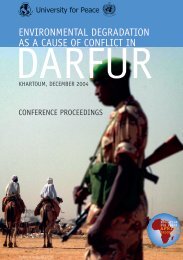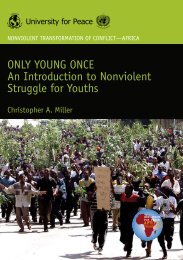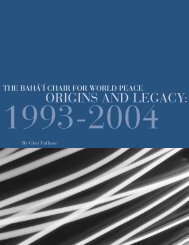who medicines strategy - libdoc.who.int - World Health Organization
who medicines strategy - libdoc.who.int - World Health Organization
who medicines strategy - libdoc.who.int - World Health Organization
You also want an ePaper? Increase the reach of your titles
YUMPU automatically turns print PDFs into web optimized ePapers that Google loves.
WHO MEDICINES STRATEGY 2004-2007 | 58EO 3.1Access to essential <strong>medicines</strong>improved, including <strong>medicines</strong> forHIV/AIDS, malaria, TB, childhoodillnesses, and noncommunicablediseasesRationaleIn 2001, the Commission on Macroeconomicsand <strong>Health</strong> 22 demonstrated the close linksbetween health and poverty reduction. The lackof access to essential <strong>medicines</strong> and other health<strong>int</strong>erventions to prevent or treat diseases suchas HIV/AIDS, TB, and malaria results in highmortality and morbidity and holds back socialand economic development. In addition, in somecountries, the lack of <strong>medicines</strong> in health facilitieshas lowered people’s confidence in the healthcare delivery system. As a result, other servicesoffered by the health system, including vitalimmunization programmes, have been adverselyaffected.ProgressThe Stop TB Partnership and the Global DrugFacility have demonstrated that: new resourcescan be mobilized; innovative partnerships, evenat grass-roots level, can be forged for effectivecountry level action; and pooled resources cancreate an effective negotiating tool for pricesetting in non-structured markets. In addition,through jo<strong>int</strong> product development agreements,WHO has been able to achieve differential pricesfor a number of key antimalarial drug products.Standard treatment guidelines for HIV/AIDS andmalaria have been reviewed and updated andreflected in the WHO Model List of EssentialMedicines and Formulary. These guidelines helpcountries to select drug products that are optimalfor their setting, taking <strong>int</strong>o account both theepidemiological situation and drug resistancepatterns. WHO is also contributing to ensuring thequality of new <strong>medicines</strong> for HIV/AIDS, TB, andmalaria through the prequalification process. Inthis way, national medicine supply systems andregulatory authorities are able to make evidencebaseddecisions about <strong>medicines</strong>.Price information on selected essential <strong>medicines</strong>is provided through a collaborative effortinvolving WHO and partners — allowing nationalprogrammes to compare medicine prices offeredby various sources. This is a valuable tool forensuring competitive pricing in the <strong>int</strong>ernational<strong>medicines</strong> market.ChallengesThe high disease burden due to HIV/AIDS,TB, and malaria in many countries is a majorchallenge for governments. Efforts to improveaccess to essential <strong>medicines</strong> for these threediseases require a substantial increase in bothhuman and financial resources, as well asstrengthened <strong>medicines</strong> supply systems. Thehigh cost of individual treatment, especially forlifelong treatment for HIV/AIDS, is a major hurdlefor many governments and individuals. Effectivedelivery of many of the <strong>medicines</strong> for thesediseases requires accurate diagnosis and closemonitoring of the patient’s response to treatment.To achieve this, it is vital that health systemsdevelop and implement the necessary supportinginfrastructure, train health staff, and providethe information needed by patients to ensureoptimal therapy. The development of resistance tocurrently available therapies is a significant threatto treatment. Innovative measures to conta<strong>int</strong>he rate and extent of drug resistance need to beidentified.











